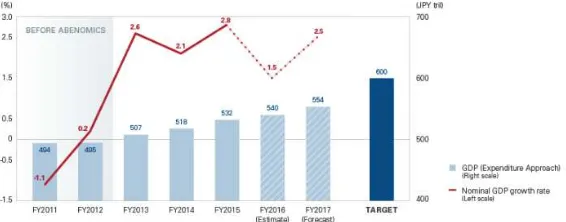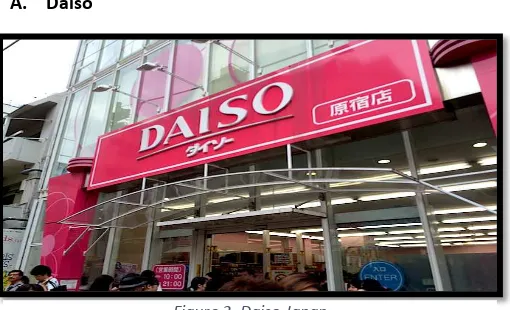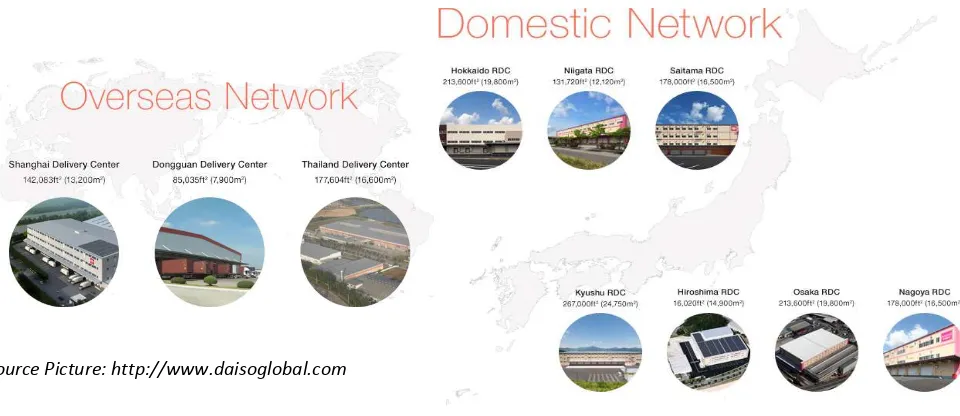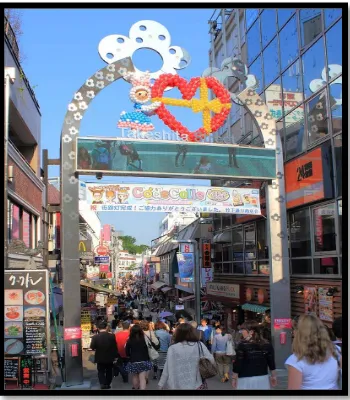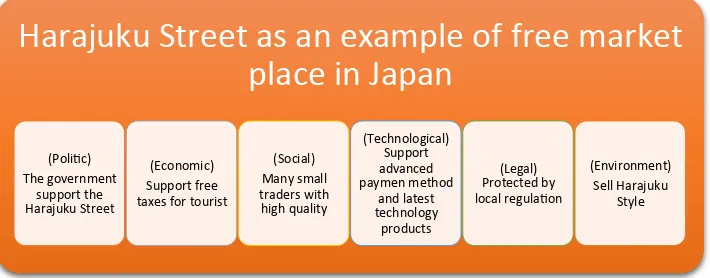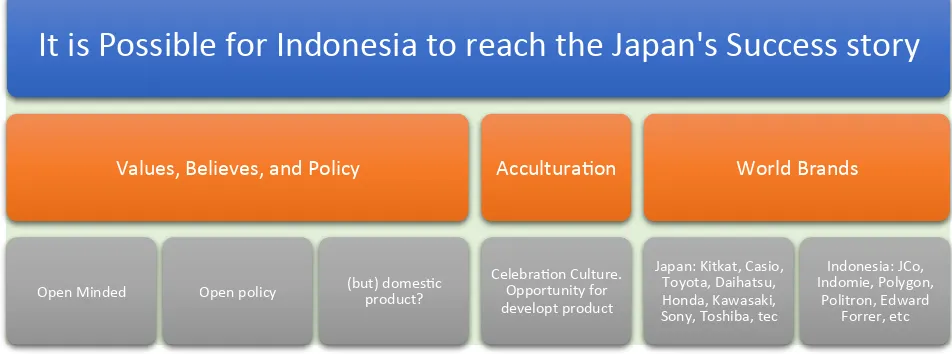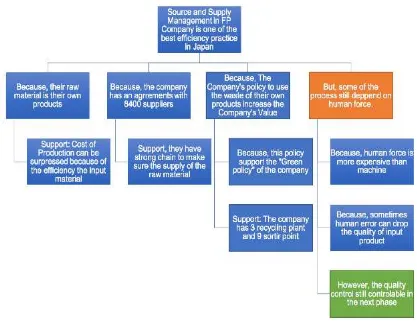THE INTERNATIONAL JOINT SEMINAR
and
VISIT FP CORPORATION
Tokyo, Japan 31 January – 4 February 2017
between Indonesia & Japan
Arranged by
Nurul Atikoh - 120820160007
Graduate School of International Cooperation Studies
Master of Management Program Faculty of Economics and Business
University of Padjadjaran
PRELIMINARY
In the last three decades, Japan as a developed country faces several problems at once. Namely, the demographic problems, stagnant economic growth for two decades, and the Fukushima crisis. However, it is not a great nation if it cannot solve big problems. Japan has once again proved to the world that they can rise from the problem. The resolution of Prime Minister Shinzo Abe or better known as Abenomics has shown quite promising results. Since its implementation in 2013, Japan has achieved the following achievements1:
1. The amount of Gross Domestic Product grew from 495 trillion to 532 trillion yen between the 2012 and 2015. The figure below illustrates the differences before and after Abenomics:
Figure 1. Comparison Graph Before and After Abenomics
2. Corporate ordinary profits increased by 20 trillion yen between 2012 and 2015 annually. 3. Unemployment rate declined from 4.3%
Abenomics strategy drive from three main gear: Productivity Boost, Innovation and Trade, and Energize Corporate Activities. Abenomics aims to reach 600 trillion Yen in the future. Some people contend that this achievement is pure because of the Abenomics and Shinzo Abe factor. However, I believe that these achievements are happening because of many internal and external factor. The traditional values of Japanese society (i.e., loyalty, detail, optimism, perfection) play a crucial role. This tradition is multiplied by the hardworking nature of Japanese society so that Abenomics strategy becomes manifest.
Padjajaran University in cooperation with Rikyo University conducted a field trip to Japan held on 31 January 2017 to 4 February 2017 to some locations. This report was created for:
1. Analyze marketing strategies undertaken in Japan in general by visiting the Daiso trading center and Harajuku Street;
2. Analyzing the impact of cross-culture between Indonesia and Japan by studying the values, beliefs, and policies applied in both countries to know the constraints faced by Indonesia as a developing country and provide input for future improvement;
3. Analyze the practice of Sourcing and Supply Management in FP Corporation.
MARKETING ANALYSIS REPORT yen stores in all of Japan, a shop called Daiso is one of the best known and touted as the most complete 100 yen. Daiso is a big 100-yen store franchise in Japan. Daiso is owned by Daiso Sangyo Corp.
Daiso carries nearly 70.000 kinds of household and personal items, ranging from knick-knacks such as Japanese-style fan, piggy bank, key chains, or stationery. Then the various makeup-like powder, eye shadow, many face cream, and mirror. Also, cooking utensils, toys and much more. Many of the conveniences offered by this shopping center. The customer can pay for their purchase with cash, various types of credit cards, including Visa, Amex, and Master Card.
Supply Chain Management Daiso
Upstream
Daiso sets itself apart from other 100 yen shops by avoiding “second factory merchandise.” Instead, they keep prices low by purchasing directly from manufacturers in very high volume. This strategy also performed by the biggest retailer in the USA, Walmart.
Daiso has several big international suppliers from Korea, Brazil, Austria, and China. Most of Daiso's products are imported from China, but with its brand products. Although most of these products made in China, Daiso has an excellent quality control to ensure the quality of their products. Moreover, Daiso design all of their product by themselves.
Sourcing and Supply Management
Daiso has a large plastic factory located in Amata City, Thailand at 890,000 ft², which is famous for its water quality. Daiso plastic products are developed using the latest injection molding techniques. The construction of the factory is aimed at developing higher quality products as well as to maintain the supply of goods Daiso. Daiso also developed ten delivery centers, 3 of them are spread between China and Thailand while the other seven are in the domestic2. Figure 3 below illustrates the spread of Daiso main factory.
In addition to a good network, Daiso also has 23 giant warehouses in domestic that maintain the quality of goods. Daiso also has a strategy in selecting local suppliers. For those who wants to become vendor, some requirements need to be completed so that the goods sold by Daiso remain qualified.
2
Figure 3. Daiso Main Factory
Source Picture: http://www.daisoglobal.com
Downstream
Daiso site selection is also highly considered to capture the number of middle-class consumers. To overcome this challenge, Daiso invests much money on shelving and fixtures so their stores can compete in the middle-class market. Moreover, their stock on their store also adjusts frequently to increase the number of loyal customers. Currently, Daiso has 3.000 stores in Japan and 522 stores abroad.
Supply Chain
Management Daiso
Strong Internaional
Supplier
3.000 stores in Japan
and 522 stores abroad
B. Harajuku Street
Harajuku area, especially on Takeshita Dori (Takeshita Street) is the center of Japan's most extreme teenage cultures and foreign tourists. The number of visitors Harajuku street indicates the successful implementation of marketing strategies.
In my opinion, Indonesia has potential to develop shopping center like Harajuku in Japan after I do the PESTLE analysis.
PESTLE Analysis, is a tool in understanding the big picture of the business environment besides the opportunities and
threats that happen around the business. Thus, this analysis
will help us to get a better understanding and create a better
strategy that maximizes the opportunities and minimize the
threats.
Specifically, the PESTLE analysis is a tool for determine a strategic positioning of our business and maximizes its potential. This analysis also used to give influence on the organization.
In this case, PESTLE analysis at Harajuku Street are:
1. Political
Political factors include applicable laws, government policies, and formal or informal rules in the corporate environment (ex-tax policies and local regulations). According to the observations in the field, the government supports the Harajuku Street. The government legalized and made Harajuku street as one of the tourist destination. Some people take advantage of this place as a center to find support from young people by organizing various events in this area.
2. Economic
Economic factors include every factor that affects the business climate of a company and the purchasing power of the customer (i.e. economic growth and exchange rate). Based on observations in the field, the price of a similar product is lower in Japan than in Indonesia. For example, the price of iPhone that was sold in Daiso Japan only 60-70% from Indonesia’s price. This lower price is due to the strength of Yen over Indonesian Rupiah. Moreover, the price for all overseas tourist did not include 7% tax.
3. Social
Social factors include everything that can affect the size of the existing market share and the needs of the customer (i.e. population growth rate, the level of people’s education, social environment condition and work environment). Based on observations in the field, there are many small traders with high-quality products. This policy decreases the number of unemployment by giving a chance to all citizens to compete in free market equally.
4. Technological
Technological factors include everything that can increase the efficiency of the company's business processes and help in facing business challenges (i.e. discoveries and development, cost and benefit of technology, and the impact that brought from technological change). All of the shopping place in Harajuku street support an advance payment method from using cash, credit card, even virtual payment like Apple Pay in some localities. This technology makes it easy for customers to shop.
5. Legal
3
Source: http://www.japan-guide.com
Legal factors include legal influences like the changes to existing or future laws (i.e. health and safety, employment direction, and environmental responsibility). Japan has strict rules on labor protection, working hours and minimum wages. Field observations show that all sellers in Harajuku street are very obedient to regulations such as not damaging the environment, not exploiting young workers, and so forth. They feel secure that the government protects their rights.
6. Environment
Environmental factors such as geographic location factors can be used to create the strategic plan to influence the customer. Harajuku street is not only a place to buy goods but also a place that sells environment. Along the street will be found a group of school children with Harajuku style. They proudly wear products sold on Harajuku street. Conscious or not, this Harajuku Style influences the customer.
Figure 4. The overview of PESTLE analysis at Harajuku Street
C. Recommendation
After doing marketing analysis on Daiso and Harajuku street, the are some recommendations to improve business practices in Indonesia:
1.
The government and the business community can create the concept of household supermarkets such as Daiso, with typical products coming from various regions in Indonesia, with reasonable price. Such as handbags from Bali woven fabric, or pencil case from Lampung cloth. In this case, the central government should collaborate effectively with local government and business community from all regions in Indonesia.2.
The businessman develops typical Indonesian products, whether in the form of goods or food. They also should create a product standard by registering it into a patent, then made a community place in the shape of a street that also sells the product.Harajuku Street as an example of free market
place in Japan
CROSS CULTURAL ANALYSIS REPORT
It is possible for Indonesia to reach the Japan's Success story through cross-culture analysis. Cross culture refers to a company's initiatives to understand better each of different groups, to create effective communication or to set up marketing efforts that can reach customers and clients outside its traditional market. The cross-cultural analysis is intended to strengthen the interaction of customer from two or more different backgrounds. This analysis is a vital issue in international business4. Cross-cultural consumer analysis is based on a research find out how do the two different customers have similar or different in their consumption indicates that Japanese people will look for newest products at any price.
2. High-quality standards standard to survive the competition in Japanese Market.
B. Acculturation
Most of the acculturation process in Japan is came from Western Culture. Namely, Christian celebration like Christmas, new year and even Halloween always celebrated massively in Japan, although the majority of Japanese society is not a Christian. Most of the Japanese customer see this celebration as the celebration without the understand the real meaning behind the event. This condition is well used by manufacturers in Japan to sell goods according to the theme of celebration.
C. World Brands
If we talked about the world brand, Japan is an outstanding market share for a brand that put forward quality with high standard. This phenomenon can be seen when visited Japan. Almost all people used iPhone brand phones. iPhone became a leading brand and dominated the mobile phone market in Japan. Some of the world's brands are also seen in food products, clothing, and electronics: Food products like Starbuck coffee; the apparel products like Uniqlo and Zara; and electronics product like Rolex watches. Japan was The Strongest Country Brands in 20146, so if the competitor wants to enter the market, they must sell/create a product with high standard and quality.
However, not all of these successful products have successfully penetrated Indonesia’s market due to halal certification problems. For example, Oreo ice cream sandwiches, Baskin Robbins Nougat, Lays Flavor Mac and Cheese or Pepsi Salty Watermelon. Most of the food products in Indonesia must have halal certification to get customer’s attentions.
4
Source: http://www.investopedia.com 5
Source: Guide Report of TAKUSHOKU Joint Seminar & Visit to Clean Authority of Tokyo - 15-19 May 2017
6
Refers to the Japanese product, a lot of Japanese products that became the world brand entered the Indonesian market. The latest product that entered was Pablo bread. On the other hand, food products such as KitKat, electronic products such as Sony, Toshiba, Hitachi, Casio and vehicles such as Honda, Toyota and Daihatsu were in the top position of the market share in Indonesia.
Interestingly, Indonesia's products that enter the Japanese market is mostly food products. The example of the products that pass through the rigorous selection of self-service and Japanese health agencies are natural honey products, herbal tea (PT Aksara Kencana Putra), ginger drink (PT Intrafood), snacks, instant noodles (PT Indofood CBP Sukses Makmur), and coffee Indonesia (PT Aimfood Manufacturing Indonesia). In addition to food products, other products such as Polygon (bicycle) and Toshiba also enter the Japanese market. However, it lacks a name in the Japanese market.
Figure 7. The overview of cross-cultural analysis
D. Recommendation
After doing cross-cultural analysis, Indonesia can imitate the process of cross-cultural marketing in Japan because Indonesia has a very strategic location between two large continents and two large oceans. Indonesia has become and plural maritime country for thousand years ago. Indonesia is a perfect place for exchange transaction from different cultures. The nature of a high consumerism of Indonesian people makes Indonesia an up-and-coming target market for Developed Country. Because of that, the government must protect Indonesian, so they are not drowning in foreign products and eliminate the flagship products of the Indonesia. If properly managed, it is not impossible that the flagship product of the Indonesia is spreading all over the world.
It is Possible for Indonesia to reach the Japan's Success story
Values, Believes, and Policy
Open Minded Open policy (but) domesic product?
Acculturaion
Celebraion Culture. Opportunity for developt product
World Brands
Japan: Kitkat, Casio, Toyota, Daihatsu, Honda, Kawasaki, Sony, Toshiba, tec
Indonesia: JCo, Indomie, Polygon,
COMPANY VISIT ANALYSIS REPORT
SOURCING AND SUPPLY MANAGEMENT IN FP CORPORATION
A. About FP Corporation
FP Corporation is a manufacturer of food places number one in Japan. This food place is used for items such as pre-cooked food that is easily damaged and bento lunch boxes that are sold in supermarkets and stores.
The strengths of FP Corporation can be seen through:
1. Products. The product is an item needed by the entire Japanese society;
2. Technology. FP Corporation has an industrial technology innovation in the processing of environmentally friendly raw materials;
3. Network Infrastructure. FP Corporation Has an infrastructure network covering all areas of Japan; 4. Recycling. FP Corporation has a good recycling system called circular recycling.
FP Corporation utilizes an infrastructure network that covers all areas in Japan with excellent Supply Chain Management (SCM) systems. In general, FP Corporation connects the capabilities of suppliers, companies through great production processes, distribution power, recycling, and information networks.
FP Corporation has run SCM supply chain management system with: 1. Preparing the manufacturing schedule;
2. Manage detailed procurement planning;
3. Developing a product inventory plan based on the sales plan;
4. Preparing the intended transfer of manufacturing equipment to the factory according to demand.
By operating the above procedure, FP Corporation can optimize overall distribution costs whereby there is a huge cost reduction enabling effective distribution to the shipping area. Therefore, the SCM practice applied by FP Corporation is one of the best business practices in Japan.
B. Sourcing and Supply Management
One of the critical stages in Supply Chain Management is the sourcing and supply management. Supply management can be defined as the identification, acquisition, and supplier relationships that a needed by the company to attain its strategic objectives. Swink (2014) claims that sourcing includes the identification, evaluation, and selection of suppliers, is an essential part of supply management.
Suppliers will provide a broad range of resources to the organization. Sourcing and Supply Management is supply management based on the results of the company visit on February 2, 2017. It is my contention that the Company has already implemented the efficient process of the supply management for several reasons.
First
Their raw material is their products. In FP Corporation, input material was obtained from the waste of their food trays products. These raw materials then were recycled into new food trays. FP Corporation manages the input material to make food dishes also made recycling plant 26 years ago. The cost of Production can be suppressed because of the efficiency the input material.
new tray. It means that the raw material of the product is a self-created product. This position benefits companies. Concerning availability of raw materials, there will always be raw materials for its products. Regarding cost, this product is produced from raw materials that do not need the purchase process.
Figure 8. FP's Recycle Process
Second
The Company has agreements with 8400 suppliers. FP Corporation’s recycling method use the trays and transparent containers from 8,400 supermarkets. These materials are sorted based on the material. The sorting point centers are spread in nine places nationwide. Currently, FP Corporation has three recycling plant specifically to manage the input for recycling of waste to produce the new tray of food. So, they have a strong chain to make sure the supply of the raw material.
In the other hand, FP Corporation gets much help to recycle used PET trays and bottles. Citizen's participation to supply PET trays and bottles is very high. The citizen collects used trays and bottles of PET inside a dump placed in supermarkets and shops. After that, the truck carrying from FP Corporation brought trash and PET bottles back to FP Corporation to be recycled. From the analysis, there are 4 actors in the collection of raw materials. There are customers, supermarkets, packaging wholesale dealers, the company itself.
Third
The Company's policy to use the waste of their products increase the Company's Value. From the foam trays and transparent trays collected and conveyed to the sorting plants in the relevant areas, they manually remove those that are unable to be recycled and send the proper trays to the material recycling process. Then, the sorted products are transported to recycling plants. This recycling plants is the place where they are reprocessed into new trays and containers. Their high degree of precision in undertaking manual sorting supports the production of high-quality Eco Tray products. This policy supports the "Green policy" of the company.
Figure 9. Analysis of Source and Supply Management in FC Company
C. Policy
In 1991 Japan enacted a Recycling Act with the aim of reducing the volume of waste and improving recycling. Under this law, the producer company should attempt to design the product in such a way that it may be recycled easily, among others, by signaling the cans whether made of steel or aluminum7.
The law on recycling of containers or wrappers that came into force in 1997 regulates the disposal of containers or packing-packaging. Consumers are required to separate PET bottles, glass and tin (steel and aluminum) bottles. Companies are required to recollect and reuse (recycle) containers of their products, like PET bottles, glass bottles and so on. Then, in April 2000 came out another law regulating the wrapping of paper and other types of plastics other than PET bottles.
Plastics and vinyl used as a cheap disposable packaging material because it is cheap to have become one of the leading causes of dioxin gas and increasing waste. Therefore, it is endeavored for its use to be limited and redefined as much as possible. Because of this government policy, FP Corporation can manage the business process well.
The Japanese government imposed strict regulations on disposing of garbage in Japan. Ranging from picking waste to disposal by categories, wrapping garbage by type until the time to get rid of trash.
Before disposing of garbage, people are asked to buy plastic bags for the garbage available in the supermarket. Plastic bags are green for the waste that can still be processed naturally / organic (Moerugomi) and white color for garbage that cannot be treated naturally / inorganic (Moenaigomi). However, these two colors do not apply in all areas because each region has its color to distinguish the two types of waste. Likewise, waste plastic purchased in Tokyo cannot be used in Hokkaido because each city has its waste plastic.
Types of Trash:
1. Moerugomi (Trash that can still be processed naturally)
Consisting of household waste, such as kitchen waste, photos, diapers, wood pieces, and pillows. For kitchen waste (food waste or fruit peel) first, squeezed, then put in a garbage bag.
2. Moenaigomi (Trash that cannot be processed naturally) Consists of several types, namely:
a. Trash cans; i.e., canned drinks, canned food, and spray cans.
b. Bottle of drink; i.e., the plastic bottle of drink, glass bottle separated by color. c. Bottle of cooking oil.
d. Plastic containers; i.e., instant noodle cups, plastic bottle caps, shampoo bottles.
e. Iron and small-scale electronic appliances; i.e., pots, hair dryers, electric carpets, fans, clocks. f. Objects containing chemical elements; i.e., batteries, lamps, thermometers.
g. Paper waste; i.e., magazines, newspapers, comics, and cardboard. Try to make this type of garbage first tied with a rope to tidy.
h. Processed plastic objects; i.e., plastic toys, cd boxes, buckets, toothbrushes, cigarette lighters. If there is a lighter, it is advisable to remove any residual gas remaining to prevent a fire.
i. Processed glassware; i.e., cups, glasses, lamps, cosmetic bottles. For glass, debris waste is required to be wrapped in advance with paper.
Trash Removal Schedule
In Japan, not everyday people can throw garbage. The citizen has to dispose of waste according to its type and disposal schedule. Moerugomi rubbish is usually discarded twice a week, and plastic type moenaigomy is usually disposed of once a week. However, this schedule also depends on every city or region, because every city has different schedules in taking out the garbage.
Special Trash
In Japan, there is also a term of particular junk or garbage that cannot be thrown away for free. Types of garbage such as cabinets, desks, chairs, TVs, computers, air conditioners, refrigerators, or microwaves, which are legal cannot be disposed of in ordinary places. If the people are going to throw away things like that, they should look back on the timetable dumping schedule that the local government has given away. People should buy a coupon to throw away the garbage, the price also varies depending on the type of item the people want to throw away, and the coupon is tacked on the item that people want to throw away as proof we throw the garbage legally.
However, there is another way if the people intend to dispose of this type of garbage without buying a coupon, they can throw it in a thrift store or "Recycle Shop." If the goods they want to dispose of is still good and under 5 years old then maybe we can get money from the goods but if the goods they want to dispose of is damaged/old and aged more than 5 years then they will not get money or maybe even have to pay To the Recycle Shop.
D. Asset Management Role
1. Asset inventory consists of two aspects, namely physical inventory and juridical/legal. Physical aspects include shape, area, location, volume/number, type, address, and others. The juridical aspect is the aspect of complete asset recording. The asset inventory indicator is:
a. Record of assets according to form, area, amount, value, and location; b. Inventory period is done at least once in five years;
c. The annual reports are always done;
d. The coding and numbering of inventory on assets have been done; e. Availability of competent human resources in handling inventory;
f. Availability of other information relating to the inventory of fixed assets of land, buildings and buildings and equipment and machinery.
2. A legal audit is the scope of asset management work in the form of an inventory of asset control status, systems and procedures for asset control or transfer, identification and finding solutions to legal problems and strategies for solving various legal issues. Legal issues that are often encountered include the alienation of unmonitored assets, or lost assets, with the indicator:
a. Land assets, buildings and equipment or machinery, have a clear and permanent ownership status; b. The completeness of proof of ownership, such as a certificate, Building Permit, goods hand over
news, purchase receipt;
c. The alienation of land, building and building assets and equipment and machinery meets applicable legal systems and procedures;
d. The group of assets with a weak mastery status.
3. Assessment of assets is a process of work to assess the assets of land, buildings and buildings and equipment and machinery controlled. Indicators in asset valuation are:
a. The value of fixed assets is objective and relevant to current conditions; b. Already earned the fair value of assets with lowest estimates;
c. Assessment is done in the preparation of balance sheet, utilization, and alienation, not for other purposes.
4. Optimization of assets is a process of work in asset management aimed at optimizing the physical, location, value, volume, legal and economic potential of the land, building and building assets and equipment and machinery. In this stage, assets owned and belonging to the Ministry of Trade are identified and grouped into potential and unlikely assets. With the indicator:
a. Assets are optimally utilized;
b. Has been grouped assets that have potential and no;
c. As an asset optimization step, idle assets are planned or can be made sales, alienation, utilization of cooperation or eliminated;
d. Land, buildings and buildings and equipment and machinery have contributed to FP Corporation revenue.
5. Supervision and control of assets aim to know and assess the actual reality of the implementation of tasks and or activities. Is it following the inside procedure or not. Whether the work being carried out can proceed by the designated plan and or the desired result has been under the established plan and the desired result by all applicable terms and policies, with the following indicators:
a. The existence of technical policy and guidance in asset management;
b. The power of the user of the goods has done the monitoring and controlling in asset management; c. Further audits have been undertaken as a result of the monitoring and control of the asset.
For the excellent performance of fixed assets owned by FP Corporation, it is necessary to perform the above-fixed asset management stages
E. Conclusion and Overview
In conclusion, the policy, and innovation applied by the company successfully transform the FP Corporation into one of the best efficiency Source and Supply Management practice in Japan.
F. Recommendation
1. The government makes regulations on waste management;
2. The business actors had an awareness of waste processing and applied a standard for the company; 3. Cooperation between the government and related business actors.
The recommendations above require commitment and awareness to be realized.
REFERENCES
http://www.japan.go.jp/abenomics/index.html
http://www.daisoglobal.com/about/logistics
http://www.japan-guide.com
http://www.investopedia.com
http://pestleanalysis.com/what-is-marketing-analysis
http://nation-brands.gfk.com
https://kbritokyo.jp
http://www.imccsub.com
http://www.fpco.jp/en/en_about/en_company.html
